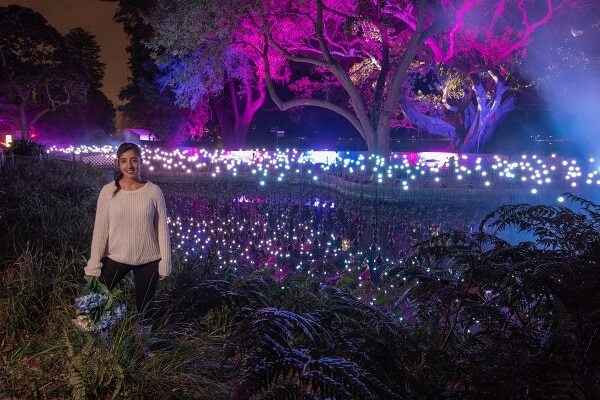A field of illuminated and dancing water lillies, the installation Oasis has been drawing crowds at Sydney’s Royal Botanic Gardens as part of the ongoing VIVID Festival.
It is created at the site of NSW’s permanent memorial to the Forgotten Australians, on the water feature known as Twin Ponds.

A stone plinth erected here in 2009, reads:
In this place, we remember the many thousands of NSW children who grew up in care in the decades leading up to the 1990s – in orphanages, in Children’s Homes and foster homes, in institutions. We remember the lonely, the frightened, the lost, the abused – those who never knew the joy of a loving family, who suffered too often at the hands of a system meant to provide for their safety and wellbeing. We rejoice in their courage and strength.

The site of this lasting memorial is currently home to another – albeit temporary – tribute to those who experienced out-of-home care. The ‘lillies’ light up to piped music, and illuminate the trees above. Artificial mist adds a touch of mystery.
Created by Gunjit Kaur, James Feng and Minh Au, Oasis aims to bring out of the shadows, the experiences of children now known as Forgotten Australians. The neglect and abuse they faced, as well as the strength and resilience that emerged, are at the core of this work of art.
Describing the installation, Gunjit told Indian Link, “Each individual flower is a slender pipe holding a bulb. It is fragile enough to sway in the wind, but strong enough not to fall over.”

In some ways, the slender pipe also evokes the ‘thread’ that is a significant part of the Western Australian memorial to the Forgotten Australians: There is a strong thread that links the way a child is raised with the person they become in adulthood. This memorial stands as a reminder of that thread to all who create policies that affect children.
The music for Oasis was painstakingly picked, James revealed. “There are elements of loneliness, fear, anxiety and neglect in our musical selections, as well as of joyful play in the natural environment, such as where this installation is set.”
The 20-minute mix is made up of bits from popular as well as classical music, and snippets from TV and radio shows.

The end is beautifully soothing, in the hope that there is some resolution, perhaps even peace.
And that, in essence, is at the aim of this evocative piece – for viewers to experience a variety of feelings as they are urged to get into the shoes of a ‘lost’ generation of kids.
It wasn’t until 2009 that care-leavers received some solace when the then Prime Minister of Australia Kevin Rudd issued a statement of acknowledgement and apology in Parliament for their maltreatment. Today there are legal and social support services available for them and their families.

Gunjit met her artist-colleagues James and Minh at uni, where she studied architecture and engineering. The trio hope to work on other creative projects in the future.
Work on Oasis commenced late last year, she revealed, as the core team sussed out the site.
“The individual units, and there are 600 of them, were created at a warehouse,” she recounted. “The base of each flower is a glass bottle filled with sand and water, and weighing 7 kg. Yes, there was a fair bit of weight lifting to be done when they were all transported to the site!”

The bulk of the work took place in the nearly two weeks of assembly. And yet, Gunjit added, the challenges continued on location. Overnight, as installation was underway, ducks flew in and tried to land in the pool, knocking over 200 of the bottles.
“It was quite stressful and I wondered at one stage whether it would all come together, we were so tight on time. It took some quick thinking on our feet, not to mention great support from the organisers, to see us through!”
PICTURE CREDITS: William Wei
READ ALSO: Sydney by night




